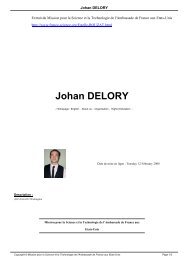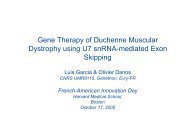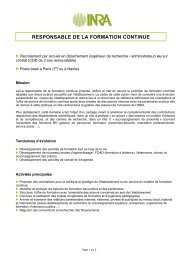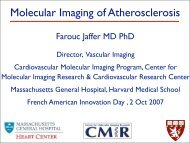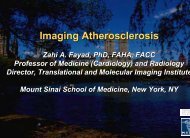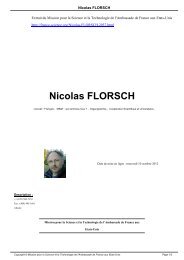Alain Stricker-Krongrad, PhD
Alain Stricker-Krongrad, PhD
Alain Stricker-Krongrad, PhD
You also want an ePaper? Increase the reach of your titles
YUMPU automatically turns print PDFs into web optimized ePapers that Google loves.
1/14<strong>Alain</strong> <strong>Stricker</strong>-<strong>Krongrad</strong>, <strong>PhD</strong>President and Chief Scientific OfficerBIOMEDICAL RESEARCH MODELS/BIOMEREEDUCATION:1993 Ph.D. Pharmacology, INSERM, University of Nancy, FranceAdvisor: Dr. B.Beck. Thesis title “Central role of neuropeptide Y”Distinction: Magna Cum Laudae2001 Post-graduate Training: Clinical Pharmacology, Drug Development and Regulation.TuftsCenter for the Study of Drug Development.Tufts University.2002 Project Management Training: Leading Project Teams in Pharmaceutical R&DTufts Center for the Study of Drug Development and Beacon Hill Technologies.Tarrytown, NY2002 Project Management Training: Management of Technological ChangeMassachusetts Institute of TechnologyCambridge, MA2003 FDA Regulation Training: The Mechanics of Prepraring INDs and NDAsCFPAEast Brunswick, NJPROFILE: Successfully carried pharmaceutical and medical product (synthetics and devices) from preformulationand conception through nonclinical development to clinical trials (I.N.D./C.T.A. andI.D.E.) Successfully carried biological products (therapeutic proteins and cell-based products) fromdiscovery through preclinical development to clinical trials (I.N.D. and C.T.A.) Demonstrated capacity to meet aggressive timelines for the delivery of therapeutic candidates toclinical status. Comprehensive understanding of pharmaceutical and medical research and development. Broad-based background including cell and molecular pharmacology, disease-based animal modelsdevelopment, drug metabolism, animal and human pharmacokinetics, and toxicology. Broad-based Animal Pharmacology and Toxicology background including rodents, canines andnon-human primates. Comprehensive experience in Efficacy and Safety Assessments and Clinical Pharmacology. Comprehensive knowledge of FDA/EMEA/ICH regulatory guidances and GLP guidelines . Demonstrated organizational, communication, publication and writing skills. Fluent in English, French and German.
2/14PROFESSSIONAL AFFILIATIONS:- American College of Toxicology- North American Academy of Clinical Toxicology- American College of Clinical Pharmacology- Safety Pharmacology Society- American Psychological Association / Division 6- Society for NeuroscienceEXPERIENCE :Biomedical Research Models and Biomere2010 (Nov)-Present President and Chief Scientific Officer• Senior Scientific Leadership: Providing senior scientific leadership and scientific oversightthrough management of all functional scientific areas. Identifying key science-based issues needingdiscussion at the appropriate meeting venue and contributing exemplary leadership in determiningadvancement of scientific programs.• Scientific Development: In charge of identifying and fostering science-related initiatives andcapabilities. Recommending and developing new technologies, techniques and/or cross-functionalcontract research services. Developing and maintaining client/sponsor relationships.• Business Development: Identifying and evaluating new capabilities to expand the revenue base ofthe company. Providing a focal point for assessing client-related program needs and proposals forimprovement and effect their implementation within the Company.• Strategic Business Leadership: Developing short- and long-term strategic plans regarding capitalinvestment, new technologies and services, and scientific staffing and facilities as they relate to theglobal expansion of the Company.Charles River Laboratories, Preclinical Services2008 (March)-2010(Nov) Chief Scientific Officer• Senior Scientific Leadership: Provided senior scientific leadership and represented PreclinicalServices as a member of senior executive management. Contributed to problem resolution of studyrelated science-based issues. Provided Study Directors and other scientists with guidance in theinterpretation and reporting of pharmacology and toxicology data.• Report and Protocol Scientific Review: Contributed to the interactions of the Study Directors withSponsors and provided scientific oversight for study design, preparation of protocols, interpretationof data, and preparation of study reports. Interacted with Study Directors and their Supervisors toensure study reports of high quality. Provided peer review of study reports.• Functional Area(s) of Expertise: Provided scientific oversight through management of allfunctional scientific areas. Identified and recommended new technologies, techniques and/or crossfunctionalmanagement of staff responsible for the specialty area. Worked directly with staff in thefunctional areas to resolve scientific and technical issues.
3/14• Preclinical Function: Participated in global cross-site initiatives related to scientific initiatives,harmonization of procedures, and standardization of templates for protocols and reports. Providedscientific and regulatory advice.• Regulatory: Participated in regulatory consulting by responding to Sponsor requests, such as thedevelopment of drug development strategies, placement of non-clinical studies, and compilation ofregulatory submissions (INDs and NDAs).• Business Development: Identified and evaluated new capabilities to expand the scientific base ofthe company. Provided a focal point for assessing client-related program needs and proposals forimprovement and effect their implementation at different sites within Preclinical Services.2006 (Jan)-2008 (Feb) Senior Director and Head of Preclinical Safety and Pharmacology andMetabolism and Pharmacokinetic Services• In charge of Pharmaceutical and Experimental Medicine (P.E.M.) for the non-clinical evaluation(efficacy and safety) of synthetics, biologics, cell-based, devices and surgical products• In charge of Metabolism and Pharmacokinetics (M.A.P.) for the non-clinical and clinicalpharmacological evaluations (metabolism and PK) of synthetics and biologics.• Directed the execution of pharmacology models (designed to evaluate efficacy) as well as nonclinicalsafety assessment (toxicology and safety pharmacology) of therapeutic candidates.• Directed the planning, execution, modeling and reporting of non-clinical (GLP) and clinicalpharmacokinetics studies (bio-availability, distribution and metabolism).• Development of short- and long-term strategic plans regarding capital investment, newtechnologies and services, and scientific staffing and facilities as they relate to the globaldepartment and the different locations.• Developed and maintained client/sponsor relationships and serve as primary sponsor contact forpharmacology as well as non-clinical safety assessment studies.• Responsible for overall coordination of study bids, study design/conduct, protocol review,consultant interactions, staffing needs, and analysis/reporting of pharmacokinetics as well as nonclinicalsafety assessment studies. Served as study director.• In collaboration with other scientific staff, provided senior-level review of protocols, reports andrelated documents for appropriate scientific content and interpretation.• Directed and supervised the following functional area: Pharmacology and Experimental Medicine,Metabolism and Pharmacokinetics, Safety Pharmacology and Preclinical Safety.• Supervised a group of more than 150 employees, including 12 <strong>PhD</strong>s and DVMs.Athersys, Cleveland, OH, USA2004(Dec)-2006(Jan) Senior Director, Head of Pharmacology2003(May)-2004(Dec) Director, Head of Pharmacology• Directed Pharmaceutical R&D for Metabolic Diseases, Oncology, CNS and Inflammation:• Identified hit series and developped leads for the three targets (sub-nanomolar potencies)• Optimized leads for pharmaceutical properties (DMPK, rodent, dog and primate)• Evaluated leads for Efficacy and Safety (acute and chronic, rodent and dog)• Moved two compounds in late stage preclinical evaluation (Safety and TOX, rodent, dog andprimate)• D.D.C. (Drug Development Candidate) status reached in May 2005 for ATX-105.• Investigational New Drug submitted in 2006 and Phase I succesfully completed in 2007.
4/14• In charge of discovery pharmacology (in vitro and in vivo) from assay development to leadidentification and optimization• In charge of preclinical efficacy and safety studies (in vitro and in vivo; rodent, dogs and N.H.P.)• In charge of pharmaceutics (in vitro and in vivo) from drug disposition and metabolism to TOXevaluations (rodent, dogs and N.H.P.)• Directing and managing the following groups: Cellular and Molecular Pharmacology, ADMET-DMPK, Efficacy and Safety Pharmacology to meet company executive goals• Supervising a group of 18 employees including 4 senior <strong>PhD</strong> scientistsMillennium Pharmaceuticals, Cambridge, MA, USA2000 - 2003(April) Senior Scientist, Head of In Vivo Pharmacology and Physiology• Planned, coordinated and directed all preclinical studies in the development of MLN4760• Met aggressive timelines for the delivery of MLN4760 to Drug Development Candidate (D.D.C.)status (company and company's partner executive management review)• Submitted physician-sponsored IND application to study MLN4760• Designed and performed studies demonstrating the new therapeutic utility of company’sproprietary products (Obesity and Diabetes)• Coordinated all animal studies of drugs with company's partner• Coordinated and established new research focus for one of the company's partner CNS productpipeline• Directed and managed Pharmacology and Physiology Groups to meet company executive goals• Supervised a group of 16 employees including 2 senior <strong>PhD</strong> scientists and 4 <strong>PhD</strong> scientists1998-2000 Scientist, Head of Metabolic Physiology• Planned, coordinated and directed studies of company’s product on GI absorption of fatty acids invitro and in animal models• Planned, coordinated and directed studies of company’s product on cancer wasting disorders invitro and in animal models• Designed and performed studies demonstrating the new therapeutic utility of company’sproprietary product using genetically-engineered mice (knockout and trangenics)• Designed and performed in vivo studies of new applications of company's genomics products• Developed and validated animals models for obesity, nutrient absorption, eating and wastingdisorders• Designed and built the Metabolic Physiology Group• Supervised a group of five employees, including 2 <strong>PhD</strong>sNovartis AG, Basel, Switzerland1996-1998 Lab-Head, Metabolic and Cardiovascular Diseases• Planned and coordinated preclinical studies in laboratory resulting in the development ofCGP71683• Established new research focus for company's neuropeptide Y antagonist program• Developed and validated animals models for obesity, nutrient absorption and eating disorders• Directed and managed in vivo Obesity and Pharmacokinetics Groups (rodent and N.H.P.) to meetproject executive goals• Developed ex vivo assay for pharmacodynamic studies• Supervised 2 <strong>PhD</strong>s and 3 laboratory assistants
5/14Ciba-Geigy, Basel, Switzerland1995-1996 Research Fellow, Metabolic and Cardiovascular Diseases• Designed and performed pilot studies of compounds on CV, CNS and neurocrine axis ex vitro andin animal models• Developed and validated immunoassays for measuring circulating hormones• Set up studies to examine the interactions of compounds with reproductive axis in rodents• Initially supervised one laboratory assistant and a <strong>PhD</strong> studentBoots Pharmaceuticals, Courbevoie, FranceINSERM U308, Nancy, France1993 - 1995 Postdoctoral Fellow• Designed and performed preclinical animal studies demonstrating the new therapeutic utility ofBTS 54524 (sibutramine, now marketed as Meridia, US and Reductil, Europe)• Designed and performed efficacy animal studies demonstrating the CNS profile of peptidicneuropeptide antagonists and agonist• Performed the statistical validation of the Dutch Eating Behavior Questionnaire in a Frenchpopulation (clinical assessment of eating disorders)• Supervised undergraduate students and one laboratory assistantACADAMIC DISTINCTIONS:Society for the Study of Ingestive Behavior’sYoung Investigator AwardPrinceton University 1992Society for the Study of Ingestive BehaviorInternational Association for the Study of Obesity’sInternational Young Investigator Competition AwardToronto 1994International Association for the Study of ObesityPATENTS:<strong>Stricker</strong>-<strong>Krongrad</strong> A and Wei G.USP 6,197,530 GPR10 as a target for identifying weight modulating compounds.Acton S, et al. and <strong>Stricker</strong>-<strong>Krongrad</strong> A.WO 02/39997 ACE-2 modulating compounds and methods of use thereofWhite DW, et al. and <strong>Stricker</strong>-<strong>Krongrad</strong> A.WO 02/074905 Leptin induced genesTartaglia LA and <strong>Stricker</strong>-<strong>Krongrad</strong> A.USPA 20030053951 Use of non-invasive imaging technologies to monitor in vivo geneexpression<strong>Stricker</strong>-<strong>Krongrad</strong> A and Wei G.
6/14USPA 20030096785 Control of hunger, satiety and food intake by modulating expression andactivity of cephalic G protein-coupled receptorsPUBLICATIONS:Beck B., <strong>Stricker</strong>-<strong>Krongrad</strong> A., Nicolas J.P., Burlet C.Chronic and continuous ICV infusion of neuropeptide Y disrupts the nycthemeral feedingpatterns in rats.Ann. N.Y. Acad. Sci. 1990, 611, 491-494.Beck B., <strong>Stricker</strong>-<strong>Krongrad</strong> A., Burlet A., Nicolas J.P., Burlet C.Influence of diet composition on food intake and hypothalamic neuropeptide Y (NPY) in the rat.Neuropeptides 1990, 17, 197-203Beck B., <strong>Stricker</strong>-<strong>Krongrad</strong> A., Burlet A., Nicolas J.P., Burlet C.Changes in hypothalamic neurotensin concentrations and food intake in rats fed a high fat diet.Int. J. Obesity 1992, 16, 361-366Beck B., <strong>Stricker</strong>-<strong>Krongrad</strong> A., Nicolas J.P., Burlet C.Chronic and continuous intracerebroventricular infusion of neuropeptide Y in Long-Evans ratsmimics the feeding behavior of obese Zucker rats.Int. J. Obesity 1992, 16, 295-302Beck B., <strong>Stricker</strong>-<strong>Krongrad</strong> A., Burlet A., Nicolas J.P., Burlet C.Specific hypothalamic neuropeptide Y variation with diet parameters in rats with food choiceNeuroreport 1992, 3, 571-574<strong>Stricker</strong>-<strong>Krongrad</strong> A., Beck B., Nicolas J.P., Burlet C.Central effects of monosodium glutamate on feeding behavior in adult Long-Evans rats.Pharmacol. Biochem. Behav. 1992, 43, 881-886<strong>Stricker</strong>-<strong>Krongrad</strong> A., Beck B., Max J.P., Nicolas J.P., Burlet C.Intracerebroventricular injection of monosodium-glutamate (MSG) stimulates food intake inLong Evans rats.In “Obesity in Europe 1991” G. AILHAUD, B. GUY-GRAND, M. LAFONTAN, D. RICQUIEREds., John Libbey (London), 1992, pp.51-54<strong>Stricker</strong>-<strong>Krongrad</strong> A., Barbanel G., Beck B., Burlet A., Nicolas J.P., Burlet C.K + - stimulated neuropeptide Y release into the paraventricular nucleus and relation to feedingbehavior in free-moving rats.Neuropeptides 1993, 24, 307-312<strong>Stricker</strong>-<strong>Krongrad</strong> A., Beck B., Nicolas J.P., Burlet C.The pros and cons in the use of intracerebral microdialysis and push-pull perfusion for harvestingheavy weight extracellular compounds : a study with neuropeptide Y.Curr. Separations, 1993, 12, 78
7/14Mertes P.M., Beck B., Jaboin Y., <strong>Stricker</strong>-<strong>Krongrad</strong> A., Carteaux J.P., Pinelli G., El Abassi K.,Villemot J.P., Burlet C. Boulanger M.Microdialysis to estimate myocardal interstitial neuropeptide Y release.Reg. Pept., 1993, 49, 81-90.Beck B., <strong>Stricker</strong>-<strong>Krongrad</strong> A., Burlet A., Nicolas J.P., Burlet C.Macronutrient type independently of energy intake modulates hypothalamic neuropeptide Y(NPY) in Long-Evans rats.Brain Res. Bull. , 1994, 34, 2, 85-91.<strong>Stricker</strong>-<strong>Krongrad</strong> A., Max J.P., Musse N., Nicolas J.P., Burlet C, Beck B.Increased threshold concentrations of neuropeptide Y for a stimulatory effect on food intake inobese Zucker rats - changes in the microstructure of the feeding behavior.Brain Res., 1994, 660, 162-166.Beck B., <strong>Stricker</strong>-<strong>Krongrad</strong> A., Musse N., Nicolas J.P., Burlet C.Putative neuropeptide Y antagonist failed to decrease overeating in obese Zucker rats.Neurosci. Letters, 1994, 181, 126-128.<strong>Stricker</strong>-<strong>Krongrad</strong> A., Beck B., Burlet C.Microdialysis and push-pull perfusion to estimate hypothalamic paraventricular neuropeptide Yrelease.in Monitoring Molecules in Neuroscience, 1994 (A. Louilot, T. Durkin, U. Spampinato, M.Cador. Eds), 354-355.Mertes P.M., El Abassi K., Beck B., Jaboin Y., Carteaux J.P., Pinelli G., <strong>Stricker</strong>-<strong>Krongrad</strong>A.,Villemot J.P., Burlet C.Interstitial myocardial norepinephrine and neuropeptide Y release following coronary occlusion.in Monitoring Molecules in Neuroscience, 1994 (A. Louilot, T. Durkin, U. Spampinato, M.Cador. Eds), 352-353.<strong>Stricker</strong>-<strong>Krongrad</strong> A., Beck B., Burlet C.Nitric oxide mediates hyperphagia of obese Zucker rats: relation to specific changes in themicrostructure of feeding behavior.Life Sciences (Pharmacol. Letters), 1995, 58 (1), 9-15.<strong>Stricker</strong>-<strong>Krongrad</strong> A., Beck B., Burlet C.Enhanced feeding response to neuropeptide Y in hypothalamic neuropeptide Y-depleted rats.Eur. J. Pharmacol., 1996, 295, 27-34.Lluch A., Kahn J.P., <strong>Stricker</strong>-<strong>Krongrad</strong> A., Ziegler O., Droin P., Mejean L.Internal validation in French of the Dutch Eating Behavior Questionnaire.European Psychiatry, 1996, 11, 198-203.Cusin I., Rhoner-Jeanrenaud F., <strong>Stricker</strong>-<strong>Krongrad</strong> A., Jeanrenaud B.Weight-reducing effect of intracerebroventricular bolus injection of leptin in genetically obesefa/fa rats : reduced sensitivity compared to lean animals.
8/14Diabetes, 1996, 45, 1446-1450.Mejean L, <strong>Stricker</strong>-<strong>Krongrad</strong> A., Lluch A.Chronobiology, nutrition and metabolism.Pathologie et Biologie, 1996, 44, 603-609.Mejean L, <strong>Stricker</strong>-<strong>Krongrad</strong> A., Lluch A.The endocrine system and diabetes.in Handbook of Experimental Pharmacology. Editors: P.H. Redfern and B. Lemmer, Springer-Verlag Berlin 1997, 125, Chapter 12, 333-350.Beck B., <strong>Stricker</strong>-<strong>Krongrad</strong> A., Burlet A., Musse N., Nicolas J.P., Burlet C.Dietary preferences in monosodium glutamate-lesioned rats: age-variable influence ofhypothalamic neuropeptideNeurosci. Letters, 1997, 225, 153-156.Schaffhauser A., <strong>Stricker</strong>-<strong>Krongrad</strong> A., Brunner L., Cumin F., Gerald C., Whitebread S.,Criscione L., Hofbauer K.G.Inhibition of food intake by neuropeptide Y Y5 receptor antisense oligodeoxynucleotides.Diabetes, 1997, 46, 1792-1798.Lollmann B., Gruninger S., <strong>Stricker</strong>-<strong>Krongrad</strong> A., Chiesi M.Detection and quantification of the leptin receptor splice variants Ob-Ra, b and e in differentmouse tissues.BBRC, 1997, 238, 648-652.Brunner L., Nick Hp., Cumin F., Chiesi M., Baum Hp., Whitebread S., <strong>Stricker</strong>-<strong>Krongrad</strong> A.,Levens N.Leptin is a physiologicaly important regulator of food intake.Int. J Obesity, 1997, 21, 1152-1160.<strong>Stricker</strong>-<strong>Krongrad</strong> A., Kozak R., Beck B., Nicolas J.P., Burlet C.Physiological regulation of neuropeptide Y release in lean and obese Zucker rats.Am. J. Physiol., 1997, 273, 42, R2112-R216.Beck B., Kozak R., <strong>Stricker</strong>-<strong>Krongrad</strong> A., Burlet C.Neuropeptide Y release in the paraventricular nucleus of Long-Evans rats treated with leptin.BBRC, 1998, 242, 636-639.<strong>Stricker</strong>-<strong>Krongrad</strong> A., Burlet C, Beck B.Behavioral deficits in the monosodium glutamate rat: specific changes in the structure of feedingbehavior.Life Sciences, 1998, 62, 2127-2132.<strong>Stricker</strong>-<strong>Krongrad</strong> A., Burlet A., Nicolas J.P., Burlet C., Beck B.Neuropeptide Y in the ventromedial and suprachiasmatic nuclei and feeding pattern inmonosodium glutamate-treated rats.
9/14Nutr. Neurosci., 1998, 1, 183-189.Wyss P., Levens N, <strong>Stricker</strong>-<strong>Krongrad</strong> A.Stimulation of feeding in lean but not obese Zucker rats by a selective neuropeptide Y Y5receptor agonist.Neuroreport, 1998, 9, 2675-2677.<strong>Stricker</strong>-<strong>Krongrad</strong> A., Burlet C, Beck B.Hypothalamic neuropeptide Y and plasma leptin after long-term high-fat feeding in the rat.Neuroscience Letters, 1998, 254(3):157-160.Schaffhauser A., Whitebread S., Haener R., Hofbauer K.G., <strong>Stricker</strong>-<strong>Krongrad</strong> A.Neuropeptide Y Y1 receptor antisense oligodeoxynucleotides enhance food intake in energydeprivedrats.Regulatory Peptides, 1998, 75-6:417-423.Wyss P., <strong>Stricker</strong>-<strong>Krongrad</strong> A., Brunner L., Crossthwaite A., Whitebread S., Criscione L.The pharmacology of neuropeptide Y receptor-mediated feeding in rats characterizes better Y5than Y1, but not Y2 or Y4 subtypes.Regulatory Peptides, 1998, 75-6:363-371.Beck B., <strong>Stricker</strong>-<strong>Krongrad</strong> A., Richy S., Burlet C.Evidence that hypothalamic neurotensin signals leptin effects on feeding behavior in normal andfat-preferring rats.Biochemical & Biophysical Research Communications, 1998, 252(3):634-638.Lubkin M., <strong>Stricker</strong>-<strong>Krongrad</strong> A.Independent feeding and metabolic actions of orexins in mice.Biochemical & Biophysical Research Communications, 1998, 253(2):241-245.Criscione L., Rigollier P., Batzl-Hartmann C., Rueger H., <strong>Stricker</strong>-<strong>Krongrad</strong> A., Wyss P.,Brunner L., Whitebread S., Yamaguchi Y., Gerald C., Heurich RO., Walker MW., Chiesi M.,Schilling W., Hofbauer KG., Levens N.Food intake in free-feeding and energy-deprived lean rats is mediated by the neuropeptide Y-5receptor.Journal of Clinical Investigation, 1998, 102(12):2136-2145.Zakrzewska KE., Cusin I., <strong>Stricker</strong>-<strong>Krongrad</strong> A., Boss O., Ricquier D., Jeanrenaud B., Rohner-Jeanrenaud F.Induction of obesity and hyperleptinemia by central glucocorticoid infusion in the rat.Diabetes, 1999, 48(2):365-370.Brunner L, Whitebread S, Leconte I, <strong>Stricker</strong>-<strong>Krongrad</strong> A, Cumin F, Chiesi M, Levens N.A peptide leptin antagonist reduces food intake in rodents.Int J Obes Relat Metab Disord. 1999 May;23(5):463-9.
10/14Klaman LD, Boss O, Peroni OD, Kim JK, Martino JL, Zabolotny JM, Moghal N, Lubkin M, KimYB, Sharpe H, <strong>Stricker</strong>-<strong>Krongrad</strong> A, Shulman GI, Neel BG, Kahn BB.Increased energy expenditure, decreased adiposity and tissue-specific insulin sensitivity inprotein-tyrosine phosphatase 1B (PTP-1B)-deficient mice.Mol Cell Biol. 2000 Aug;20(15):5479-89.Schaffhauser AO, <strong>Stricker</strong>-<strong>Krongrad</strong> A, Hofbauer KG.NPY Y5 receptor subtype. Pharmacological characterization with antisense oligodeoxynucleotidescreening strategy.Methods Mol Biol. 2000;153:129-50.White DW, Zhou J, <strong>Stricker</strong>-<strong>Krongrad</strong> A, Ge P, Morgenstern JP, Dembski M, Tartaglia LA.Identification of leptin-induced transcripts in the mouse hypothalamus.Diabetes. 2000 Sep;49(9):1443-50.Beck B, <strong>Stricker</strong>-<strong>Krongrad</strong> A, Burlet A, Cumin F, Burlet C.Plasma leptin and hypothalamic neuropeptide Y and galanin levels in Long-Evans rats withmarked dietary preferences.Nutr. Neurosci. 2001, 4, 39-50.<strong>Stricker</strong>-<strong>Krongrad</strong> A, Dimitrov T., Beck B.Central and peripheral dysregulation of melanin-concentrating hormone in obese Zucker rats.Mol. Brain Res. 2001, 92, 43-48.Beck B, Richy S, Dimitrov T, <strong>Stricker</strong>-<strong>Krongrad</strong> A.Opposite regulation of hypothalamic orexin and neuropeptide Y receptors and peptideexpressions in obese Zucker rats.Biochem Biophys Res Commun. 2001 Aug 24;286(3):518-23.<strong>Stricker</strong>-<strong>Krongrad</strong> A, Richy S, Beck B.Orexins/hypocretins in the ob/ob mouse: hypothalamic gene expression, peptide content andmetabolic effects.Regul Pept. 2002 Mar 15;104(1-3):11-20.Beck B, Burlet A, Max JP, <strong>Stricker</strong>-<strong>Krongrad</strong> A.Effects of long-term ingestion of aspartame on hypothalamic neuropeptide Y, plasma leptin andbody weight gain and composition.Physiol Behav. 2002 Feb 1-15;75(1-2):41-7.Beck B, Musse N, <strong>Stricker</strong>-<strong>Krongrad</strong> A.Ghrelin, macronutrient intake and dietary preferences in long-evans rats.Biochem Biophys Res Commun. 2002 Apr 12;292(4):1031-5.Zabolotny JM, Bence-Hanulec KK, <strong>Stricker</strong>-<strong>Krongrad</strong> A, Haj F, Wang Y, Minokoshi Y, KimYB, Elmquist JK, Tartaglia LA, Kahn BB, Neel BG.PTP1B regulates leptin signal transduction in vivo.Dev Cell. 2002 Apr;2(4):489-95.
11/14Ogier V, Ziegler O, Mejean L, Nicolas JP, <strong>Stricker</strong>-<strong>Krongrad</strong> A.Obesity is associated with decreasing levels of the circulating soluble leptin receptor in humans.Int J Obes Relat Metab Disord. 2002 Apr;26(4):496-503.<strong>Stricker</strong>-<strong>Krongrad</strong> A, Beck B.Modulation of hypothalamic hypocretin/orexin mRNA expression by glucocorticoids.Biochem Biophys Res Commun. 2002 Aug;296(1):129-33.Gimeno RE, Hirsch DJ, Punreddy S, Sun Y, Ortegon AM, Wu H, Daniels T, <strong>Stricker</strong>-<strong>Krongrad</strong>A, Lodish HF, Stahl A.Targeted deletion of fatty acid transport protein-4 results in early embryonic lethality.J Biol Chem. 2003 Dec 5;278(49):49512-6.Beck B, Richy S, <strong>Stricker</strong>-<strong>Krongrad</strong> A.Ghrelin and body weight regulation in the obese Zucker rat in relation to feeding state anddark/light cycle.Exp Biol Med (Maywood). 2003 Nov;228(10):1124-31.Gu W, Geddes B, Zhang C, Foley K and <strong>Stricker</strong>-<strong>Krongrad</strong> A.The prolactin-releasing peptide receptor (GPR10) regulates body weight homeostasis in mice.J Mol Neurosci. 2004 Feb-Apr;22(1-2):93-103.Perreault M, Istrate N, Wang L, Tozzo S and <strong>Stricker</strong>-<strong>Krongrad</strong> A.Resistance to the orexigenic effect of ghrelin in dietary-induced obesity in mice: reversal afterweight loss.International Journal of Obesity. 2004 July;28(7):879-885.Kim JK, Gimeno RE, Higashimori T, Kim HJ, Choi H, Punreddy S, Mozell RL, Tan G, <strong>Stricker</strong>-<strong>Krongrad</strong> A, Hirsh DJ, Fillmore JJ, Liu ZX, Dong J, Cline G, Stahl A, Lodish HF and SchulmanGI.Inactivation of fatty acid transport protein 1 prevents fat-induced insulin resistance in skeletalmuscle.JCI. 2004 March;113(5):756-763.Beck B, Max JP, Richy S and <strong>Stricker</strong>-<strong>Krongrad</strong> A.Feeding response to a potent prolactin-releasing peptide agonist in lean and obese Zucker rats.Brain Res. 2004 July;1016(1):135-138.Babic A, Lai M, Wang H, Daniels T, Felbinger T, Burger P, <strong>Stricker</strong>-<strong>Krongrad</strong> A and Wagner D.Leukocyte adhesion through ICAM-1 and b2 integrin regulates fat oxidation and insulinclearance during fasting.Molecular Medicine 2004 Dec 3Beck B, Richy S, <strong>Stricker</strong>-<strong>Krongrad</strong> A.Feeding response to ghrelin agonist and antagonist in lean and obese Zucker rats.Life Sci. 2004 Dec 10;76(4):473-8.
12/14<strong>Stricker</strong>-<strong>Krongrad</strong> A, Beck B.Up-regulation of neuropeptide Y receptors in the hypothalamus of monosodium glutamatelesionedSprague-Dawley rats.Nutr Neurosci. 2004 Aug;7(4):241-5.Robarge MJ, Bom DC, Tumey LN, Varga N, Gleason E, Silver D, Song J, Murphy SM, EkemaG, Doucette C, Hanniford D, Palmer M, Pawlowski G, Danzig J, Loftus M, Hunady K, Sherf BA,Mays RW, <strong>Stricker</strong>-<strong>Krongrad</strong> A, Brunden KR, Harrington JJ, Bennani YL.Isosteric ramatroban analogs: selective and potent CRTH-2 antagonists.Bioorg Med Chem Lett. 2005 Mar 15;15(6):1749-53.Song J, Doucette C, Hanniford D, Hunady K, Wang N, Sherf B, Harrington JJ, Brunden KR,<strong>Stricker</strong>-<strong>Krongrad</strong> A.Generation of cell lines for drug discovery through random activation of gene expression:application to the human histamine H3 receptor.Assay Drug Dev Technol. 2005 Jun;3(3):309-18.Anderson JT, Ting AE, Boozer S, Brunden KR, Crumrine C, Danzig J, Dent T, Faga L,Harrington JJ, Hodnick WF, Murphy SM, Pawlowski G, Perry R, Raber A, Rundlett SE,<strong>Stricker</strong>-<strong>Krongrad</strong> A, Wang J, Bennani YL.Identification of novel and improved antimitotic agents derived from noscapine.J Med Chem. 2005 Nov 17;48(23):7096-8.Murphy SM, Palmer M, Poole MF, Padegimas L, Hunady K, Danzig J, Gill S, Gill R, Ting A,Sherf B, Brunden K, <strong>Stricker</strong>-<strong>Krongrad</strong> A.Evaluation of functional and binding assays in cells expressing either recombinant or endogenoushERG channel.J Pharmacol Toxicol Methods. 2006 Jul-Aug;54(1):42-55.Song J, Hanniford D, Doucette C, Graham E, Poole MF, Ting A, Sherf B, Harrington J, BrundenK, <strong>Stricker</strong>-<strong>Krongrad</strong> A.Development of homogeneous high-affinity agonist binding assays for 5-HT2 receptor subtypes.Assay Drug Dev Technol. 2005 Dec;3(6):649-59.Huck BR, Llamas L, Robarge MJ, Dent TC, Song J, Hodnick WF, Crumrine C, <strong>Stricker</strong>-<strong>Krongrad</strong> A, Harrington J, Brunden KR, Bennani YL.The identification of pyrimidine-diazabicyclo[3.3.0]octane derivatives as 5-HT2C receptoragonists.Bioorg Med Chem Lett. 2006 Jun 1;16(11):2891-4.Hubbard B, Doege H, Punreddy S, Wu H, Huang X, Kaushik VK, Mozell RL, Byrnes JJ,<strong>Stricker</strong>-<strong>Krongrad</strong> A, Chou CJ, Tartaglia LA, Lodish HF, Stahl A, Gimeno RE.Mice deleted for fatty acid transport protein 5 have defective bile acid conjugation and areprotected from obesity.Gastroenterology. 2006 Apr;130(4):1259-69.
13/14Huck BR, Llamas L, Robarge MJ, Dent TC, Song J, Hodnick WF, Crumrine C, <strong>Stricker</strong>-<strong>Krongrad</strong> A, Harrington J, Brunden KR, Bennani YL.The design and synthesis of a tricyclic single-nitrogen scaffold that serves as a 5-HT2C receptoragonist.Bioorg Med Chem Lett. 2006 Aug 1;16(15):4130-4.Beck B, Richy S and <strong>Stricker</strong>-<strong>Krongrad</strong> A.Responsiveness of obese Zucker rats to [D-Trp34]-NPY supports the targeting of Y5 receptor forobesity treatment.Nutr Neurosci. 2007 Oct-Dec;10(5-6):211-4.Sani SN, Henry K, Böhlke M, Kim J, <strong>Stricker</strong>-<strong>Krongrad</strong> A, Maher TJ.The effects of drug transporter inhibitors on the pharmacokinetics and tissue distribution ofmethotrexate in normal and tumor-bearing mice: a microdialysis study.Cancer Chemother Pharmacol. 2010 May;66(1):159-69. Epub 2009 Oct 9Tumey LN, Robarge MJ, Gleason E, Song J, Murphy SM, Ekema G, Doucette C, Hanniford D,Palmer M, Pawlowski G, Danzig J, Loftus M, Hunady K, Sherf B, Mays RW, <strong>Stricker</strong>-<strong>Krongrad</strong>A, Brunden KR, Bennani YL, Harrington JJ.3-Indolyl sultams as selective CRTh2 antagonists.Bioorg Med Chem Lett. 2010 Jun 1;20(11):3287-90. Epub 2010 Apr 14.Anderson JT, Campbell M, Wang J, Brunden KR, Harrington JJ, <strong>Stricker</strong>-<strong>Krongrad</strong> A, Song J,Doucette C, Murphy S, Bennani YL.Investigation of 4-piperidinols as novel H3 antagonists.Bioorg Med Chem Lett. 2010 Nov 1;20(21):6246-9. Epub 2010 Aug 24.Rabito CA, van Tongeren S, Zavorskas PA, <strong>Stricker</strong>-<strong>Krongrad</strong> A, Robb J, Haupert GT Jr.Measurement of glomerular filtration rate in anesthetized and conscious rhesus monkeys (Macacamulatta).Am J Vet Res. 2010 Dec;71(12):1492-9.Braun A, Dofiles L, Rousselle S, Guerrero L, Gunther J, Yednock T, <strong>Stricker</strong>-<strong>Krongrad</strong> A,Messersmith E.Effects of an alpha-4 integrin inhibitor on restenosis in a new porcine model combiningendothelial denudation and stent placement.PLoS One. 2010 Dec 13;5(12):e14314TRADE PUBLICATIONS:<strong>Stricker</strong>-<strong>Krongrad</strong> A and Stephen Wilson.Guarding the Heart.Drug Discovery and Development. 2009 June; Vol 12 No 6: 26-28.http://www.dddmag.com/Article-Guarding-the-Heart-060109.aspx
14/14<strong>Stricker</strong>-<strong>Krongrad</strong> A and Stephen Wilson.Minimizing Cardiovascular Liabilities Throughout Drug Development.Drug Delivery Technologies. 2009 Oct; Vol 9 No 9: 77-79.http://www.drugdeliverytech-online.com/drugdelivery/200910/<strong>Stricker</strong>-<strong>Krongrad</strong> A and Smith E.How to Ensure the Best Chance of Success for your Therapeutic Proteins Programs.Life Science Leader. Editorial of November 05 2009.http://www.lifescienceleader.com



